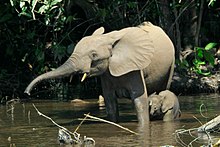Nki National Park
| Nki National Park | |
|---|---|
World Wildlife Fund |
Nki National Park (Parc national de Nki, also Réserve de Nki) is a
History
The
Today, logging is no longer a major problem,[3] as "it would require a lot of investment to develop necessary infrastructure, such as roads, for [its] operations, especially in the southern portion of Nki."[1] According to the WWF's scientific advisor in the region, Paul Robinson Ngnegueu, "poaching is the biggest threat to ... Nki."[3] It is a result of the late 1980s economic depression in Cameroon. The indigenous people followed the poachers, attracted by the financial opportunities. They would sell their product through "intermediaries" for money and more hunting supplies.[4]
Cameroonian authorities fought poaching in Nki by applying repressive measures to the indigenous population. An example of this was in January 1997, when Bakas were forced from their homes near Mambele. These actions turned the Bakas against the WWF, which they considered "an organization of whites who want to protect animals".[4] Every year, poachers travel up the Dja for central Nki, where elephant ivory is abundant. Strong currents on the river are a deterrent for half the year, but after that, according to freelance journalist Jemini Pandya, the fauna is easy to prey upon.[3]
Nonetheless, when Pandya of the WWF visited Nki National Park in the early 1990s, she described it as "the last true wilderness."[1] In 1995, the park was named an Essential Protection Zone, its first official status.[4] It was not formally established as a national park until the Cameroonian government decreed the creation of Boumba Bek and Nki National Parks on 17 October 2005.[3] This establishment was not without opposition; the Bakas have continually asked to reduce the park's boundaries and ask for higher usage rights, which invaded upon "their" land.[4]
Cameroon and Gabon are currently working on the TRIDOM project, a conservation initiative leading to a land management plan which will oversee access to and use of forests. It will create a tri-national "interzone" bordered by the
Geography and climate
The park is located in a remote area of southeastern Cameroon, which "has helped maintain most of its pristine forest and beauty."
Seventy-three bais, or forest clearings, have been discovered in Nki National Park.[6] In April 2006, while looking for elephant groups, a WWF team discovered the largest bai in the region, Ikwa Bai. Dr. Mike Loomis, a member of the group, confirmed that this bai is slightly larger than Dzanga Sangha Bai (Central African Republic), which had previously held the record. He also reported little human development adjacent to the bai, and noticed 21 elephants and 16 buffaloes in it simultaneously. The bai has a small creek running through its center, which sits atop a bed of rocks and sand. A large mineral pit is located next to the stream.[1] It is the habitat of several wildlife species, the largest-numbering being chimpanzees, elephants, buffaloes, and gorillas.[6]
The park has a tropical climate with temperature ranging from 23.1–25˚C with an average annual temperature of 24˚C. Its relative humidity varies between 60 and 90% while annual rainfall is 1500 mm per year.[6] According to the Cameroon Ministry of Agriculture, nearby Moloundou has a rainy season from September to November, a dry season from November to March, a rainy season from March to June, and a dry season from July to August.[4]
Demographics
The area around the park, as defined by the
Biodiversity
Flora
As with Boumba-Bek to the northeast, the main type of forest is semi-evergreen with an open canopy dominated by the 50–60 m Triplochiton, though it is mixed with large patches of closed evergreens. There are also some seasonally flooded Uapaca trees along the Dja River.[8]
Fauna

Nki, according to the Environmental News Service, "encompass[es] a biodiverse group of plants and animals."
The forests of Cameroon contain some of the highest population density of
A 20-day study held by
See also
- List of national parks of Cameroon
References
- ^ a b c d e f g h Ngea, Peter. "Wildlife Sanctuary Found in Nki National Park". Field Trip Earth. North Carolina Zoological Society. Archived from the original on 2012-02-15. Retrieved 2008-08-29.
- ^ World Wildlife Fund. 2006-05-26. Archived from the originalon 2008-04-15. Retrieved 2008-09-01.
- ^ a b c d e f g h "Cameroon's Two New National Parks Shelter Forests, Wildlife". Environment News Service. 2005-10-17. Retrieved 2008-08-28.
- ^ a b c d e f g h Ndameu, Benoit (July 2001). "Case Study 7: Cameroon-Boumba Bek" (PDF). Forest Peoples Programme. Moreton-in-Marsh. Archived from the original (PDF) on 2008-07-23.
- ^ "From the Congo Basin (Letter to the Editor)". World Watch. Goliath Business Knowledge On Demand. 2005-01-01. Retrieved 2008-09-02.
- ^ World Wildlife Fund. Retrieved 2008-08-28.
- ^ Belda, Van de Vyver & Moreau 2006, p. 223.
- ^ a b c "Nki (Important Birds Areas of Cameroon)". BirdLife International. Retrieved 2008-09-01.
- ^ Thieme et al. 2005, p. 230.
- ^ Manga, Pegue (2006-03-06). "The Journey To Virgin Land". The Post (Cameroon). Retrieved 2008-09-01.
Bibliography
- Belda, Pascal L.; Van de Vyver, Frederic; Moreau, Jean-Francois (2006). Cameroon: The Premier Guidebook for Business Globetrotters. OCLC 71165468.
- Thieme, Michele L.; Robin Abell; Melanie L. J. S. Stiassny; Paul Skelton; Bernhard Lehner; Eric Dinerstein; Guy G. Teugels; Neil Burgess; Andre Kamdem Toham; David Olson (2005). Freshwater Ecoregions of Africa and Madagascar: A Conservation Assessment. OCLC 57000776.
